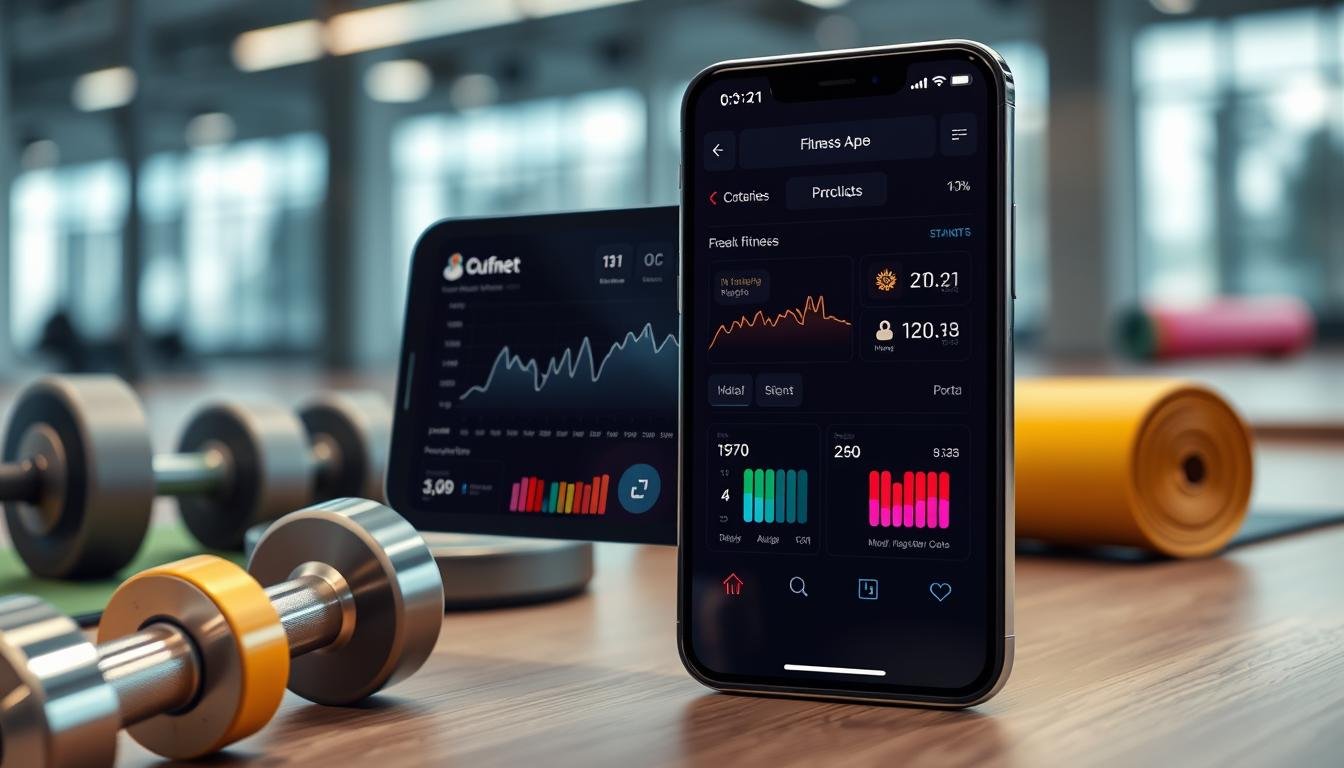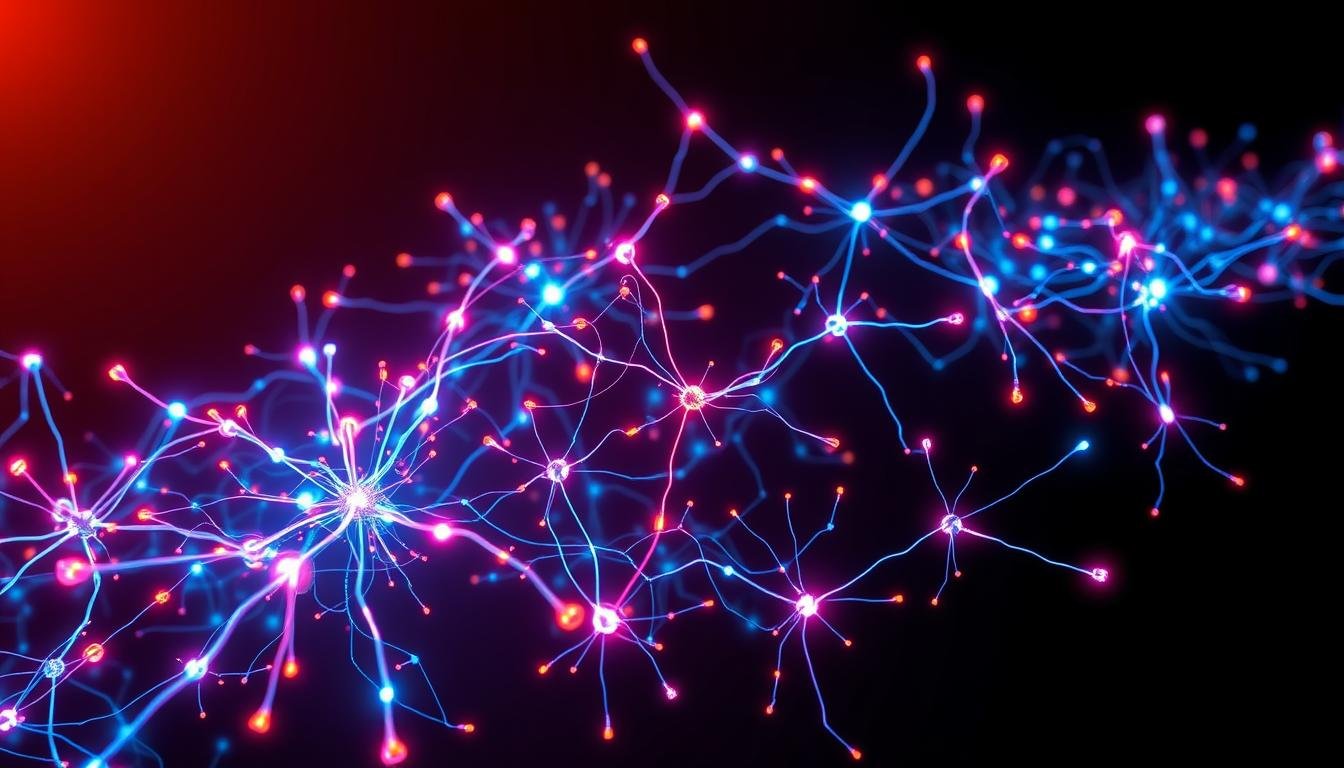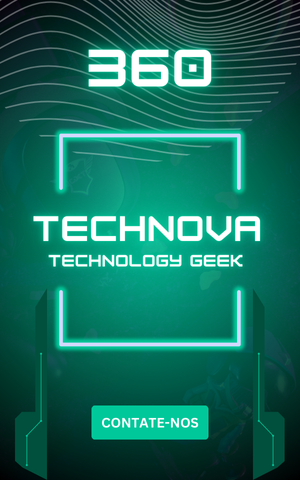The fitness world is changing fast, thanks to AI apps. These apps are not just simple tools; they are advanced platforms. They use AI to make your workouts better by analyzing your data and offering customized plans.
AI apps make fitness more personal and accurate. They adjust your workouts based on your likes and progress. They also give you feedback on your form and technique in real-time. This article will show you how to use AI apps to better your health and fitness.
Key Takeaways
- AI-powered fitness apps revolutionize the way we approach health and wellness, with the global market for AI in fitness apps predicted to reach $81.47 billion by 2028.
- These apps personalize fitness experiences by analyzing user data, offering tailored workout plans, and providing real-time performance tracking.
- AI integration enhances personalization, efficiency, and scientific accuracy in fitness practices, transforming the industry.
- Leveraging the benefits of AI-based fitness apps can help you track and improve your overall health and fitness more effectively.
- The integration of AI in fitness apps is a growing trend, with the potential to revolutionize the future of fitness software and wearable technology.
Understanding AI-Based Fitness Technology
The fitness tech market has changed a lot lately, thanks to AI. AI-based fitness apps are changing how we think about health and fitness. They use smart algorithms and data from many workouts to make exercise plans better for each person.
Evolution of Fitness Apps and AI Integration
The COVID-19 pandemic made people look for ways to stay fit at home. AI-powered fitness apps became a big help. They use your info, like age and fitness goals, to give you advice that fits you.
Current Market Trends and Statistics
The fitness app market hit $1.3 billion in 2022 and is growing fast. This growth is because of AI-based fitness tech, which makes workouts more personal. For example, FitnessAI’s tech helps people lose fat and build muscle better than old ways.
How AI Transforms Personal Training
AI is changing personal training by offering virtual coaching and custom plans. Apps like KinesteX use tech to check your form and give feedback. Freeletics also uses AI to make workout plans that get better over time, making workouts fun and unique.
“AI-based fitness apps are revolutionizing the way individuals approach their health and wellness journeys, offering personalized experiences and enhanced engagement.” – [Your Name], Fitness Journalist
Key Features of Modern AI Fitness Applications
In the fast-changing world of fitness tech, AI fitness apps are changing how we see personal health. These apps use artificial intelligence to give us personalized fitness plans. They track our performance and suggest what to eat, making fitness easier and more effective.
AI fitness apps are great at creating workout plans just for you. They use machine learning to know your fitness level and goals. This means you get workouts that really help you reach your fitness goals.
These apps also track your activity in real-time. They work with wearables to monitor your heart rate, steps, and calories burned. This helps you understand how well you’re doing and make better choices for your workouts.
AI fitness apps also offer nutrition advice to help you stay healthy. They look at your data to suggest meals and diets that fit your fitness goals. Whether you want to lose weight or build muscle, they have tips to help.
Using AI in fitness apps has made people more engaged and happy. Studies show these apps keep users active for 23% longer and make them 88% happier. As more people use these apps, AI will play a bigger role in our health and fitness.
“AI-powered fitness apps are revolutionizing the way we approach personal health and wellness, delivering customized solutions that help us achieve our fitness goals more effectively.”
The future of AI in fitness looks bright. With better machine learning and sensors, these apps will get even smarter and easier to use. By using these tools, we can start a journey to a healthier, more active life, thanks to AI.
How to Get Started with AI-Based Fitness Apps: Track and Improve Your Health
The global Artificial Intelligence in Fitness and Wellness Market was worth USD 7.80 billion in 2022. It’s expected to grow at a Compound Annual Growth Rate (CAGR) of 20.5%. This could make it worth USD 30.56 billion by 2030. This shows how popular and effective AI-based fitness apps are becoming for tracking and improving health.
Creating Your Fitness Profile
To start with an AI-based fitness app, first create a detailed user profile. This includes your age, weight, height, fitness goals, and medical history. By sharing this info, the AI can tailor your fitness program to fit your needs.
Setting Realistic Goals
After setting up your profile, it’s key to set realistic fitness goals. AI workout apps can assess your fitness level and suggest goals you can reach. They use advanced algorithms to learn from you and improve your program over time.
Understanding App Interface and Navigation
It’s important to get familiar with the app’s interface and navigation. These apps offer features like personalized workout plans, real-time feedback, and tracking your progress. Knowing how to use these features will help you get the most out of the app’s AI capabilities.

AI-integrated workout apps can keep users engaged more than traditional apps. The interactive AI features learn from user interactions, making the app better over time.
By creating a detailed profile, setting achievable goals, and understanding the app, you can use AI to improve your health. This way, you can reach your fitness goals more effectively.
Personalized Workout Planning with AI
AI technology has changed the fitness world. It’s now in mobile apps, making health and wellness goals easier to reach. These apps create AI-powered workout routines just for you.
Apps like Transform by Wegile use smart algorithms. They look at your fitness level, goals, and what you like. Then, they make adaptive exercise plans that get harder but still doable.
The AI considers your BMI, past workouts, and goals. It makes sure your fitness plan is fun and keeps you moving. This keeps you excited and motivated to keep going.
| Key Factors Considered by AI Fitness Apps | How the AI Customizes the Workout Plans |
|---|---|
|
|
These apps keep you interested and moving forward. They change your plan based on how you do and what you say. This way, you stay challenged and supported.
“The workout plans are adapted based on the days and time available to the user, allowing for flexibility in scheduling.”
In short, AI in fitness apps has changed how we work out. They make personalized workout plans that fit your life and goals. This helps you reach your fitness goals better and faster.
Real-Time Performance Tracking and Analysis
In the world of AI-powered fitness apps, tracking and analyzing your performance in real-time has changed the game. These apps use advanced technology to monitor and improve your fitness journey. They track your heart rate, breathing, and movement to give you insights to improve your physical limits.
Movement Pattern Recognition
AI-based fitness apps can recognize and analyze your movement patterns. They use computer vision and machine learning to spot form issues, helping you avoid injuries. This feedback lets you improve your technique, making every workout count.
Progress Monitoring Systems
Tracking your progress is key to reaching your fitness goals. AI apps use sensor data analysis to monitor your performance over time. They help you see your fitness progress tracking and adjust your routine. These systems offer detailed performance analytics, from personal bests to areas needing improvement.
Performance Metrics and Insights
AI fitness apps turn raw data into useful insights. They analyze your workouts to give you performance metrics, personalized tips, and predictions. This data-driven approach helps you make better decisions, optimize your training, and achieve lasting fitness gains.

AI technology has transformed fitness apps, changing how we approach health and wellness. These apps empower you to control your fitness journey, optimize workouts, and reach your physical potential.
Nutrition and Diet Management Features
AI has changed how we think about food and exercise. It looks at what we like to eat and how much we burn. Then, it suggests meals that fit our fitness goals.
Now, some apps work with smart home devices like fridges. They check what food we have and plan meals for us. This helps us eat well and avoid wasting food.
- AI in nutrition apps lets us log meals with just one photo.
- Apps like MyFitnessPal and Lose It! use smart tech to identify foods in photos.
- RxFood, used in health care, checks meal photos against big databases for nutrition info.
AI in nutrition does more than just plan meals. It gives us feedback and advice on the go. It helps us track our progress towards health goals. AI apps are making our health journey better.
| AI Nutrition App | Key Features | Reported Benefits |
|---|---|---|
| RxFood | – Meal photo recognition – Nutritional data analysis – Healthcare integration |
– 1.3% A1C reduction for type 2 diabetes – 0.8% A1C reduction for type 1 diabetes – 75% time savings for healthcare providers |
| SnapCalorie | – Conversational AI for diet advice – Personalized nutrition recommendations |
– Comprehensive food tracking – Tailored guidance based on user data |
| MyFitnessPal, Lose It! | – Meal scanning for nutrient info – Macronutrient, micronutrient, and caloric analysis |
– Enhanced accessibility to nutrition data – Continuous monitoring and recommendations |
As AI in meal planning and nutrition grows, fitness apps will get even better. They will offer a more complete and personal health plan for us.

Integration with Wearable Devices
AI-powered fitness apps now work smoothly with smartwatches and fitness trackers. These devices collect data like steps, distance, calories, and heart rate. The apps then analyze this data to give users insights into their fitness and health.
Compatible Devices and Syncing
AI fitness apps work with many wearable devices. This lets users easily sync their data and track their progress. Whether it’s an Apple Watch or a fitness tracker, users can monitor their health in real-time. This helps the AI give more accurate and personalized fitness advice.
Data Collection and Analysis
Wearable devices help collect a lot of health and fitness data. The AI turns this data into useful insights. Users learn about their activity, sleep, and overall health. This helps them make better choices about their health and fitness goals.
Health Metrics Monitoring
By linking fitness apps with wearable devices, users can understand their health better. They can see their heart rate, blood oxygen, and sleep patterns. The AI in these apps offers tailored advice, tracks progress, and finds areas for improvement. This helps users improve their fitness and well-being.
| Wearable Device | Supported Health Metrics | AI-Powered Features |
|---|---|---|
| Apple Watch | Heart rate, steps, distance, calories, sleep, blood oxygen | Personalized workout recommendations, progress tracking, health insights |
| Fitbit Versa 3 | Heart rate, steps, distance, calories, sleep, active minutes | Goal-setting, activity tracking, sleep analysis, wellness coaching |
| Garmin Forerunner 945 | Heart rate, steps, distance, calories, sleep, VO2 max | Training plans, performance analytics, recovery insights |
“The integration of fitness apps with wearable devices has transformed the way we approach health and fitness, providing users with a comprehensive and personalized approach to improving their well-being.”
Maximizing AI-Powered Training Benefits
To get the most out of AI fitness apps, it’s key to stay active and share your thoughts. By sharing your workout data and goals, the AI can tailor your experience. This means you get better virtual personal training and real-time tips to boost your workout efficiency.
Using the app’s social features and motivational tools can also help. Competing or joining challenges powered by AI fitness optimization adds fun. It keeps you motivated and on track with your fitness goals.
AI fitness apps offer a personalized training experience that fits your needs. This approach helps you reach your fitness goals and improves your health and wellness. It’s all thanks to virtual personal training and data-driven insights.






